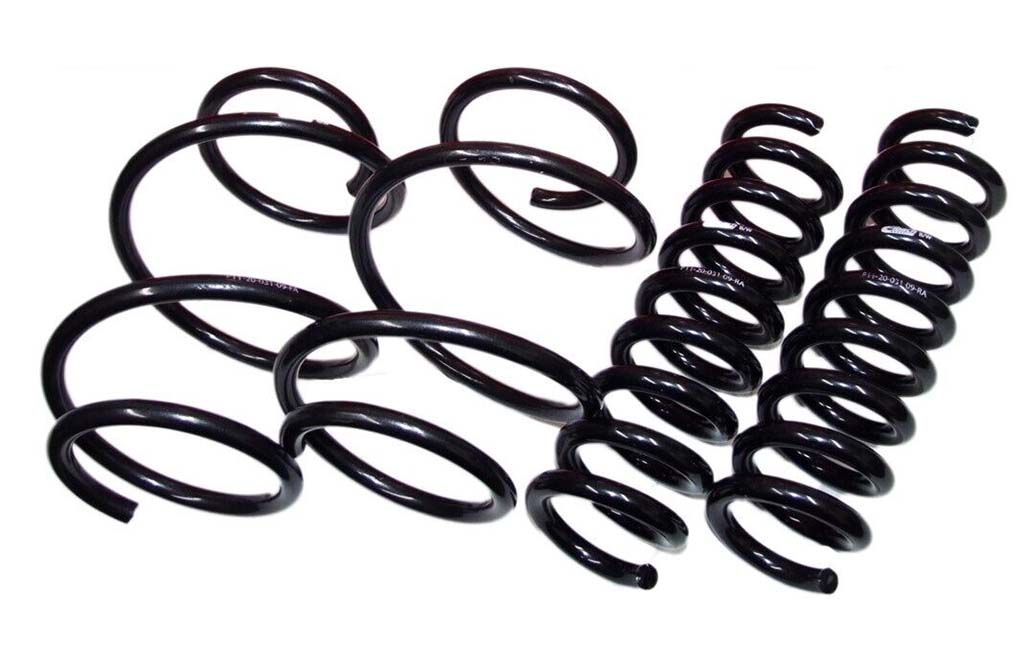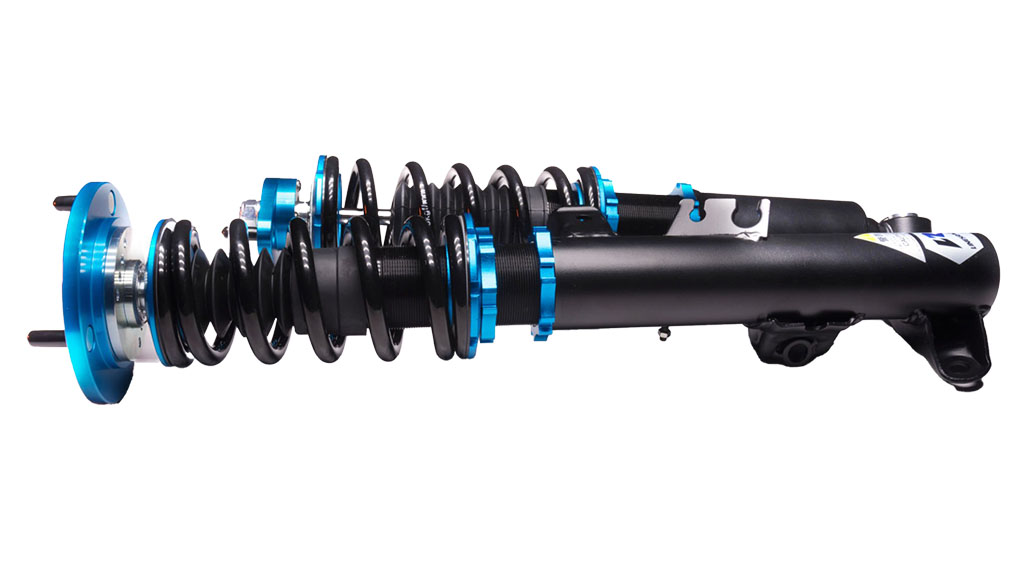When modifying a car’s stance, suspension characteristics and handling, adjustable coilovers and lowering springs are two of the most popular mods. But how what are the main differences, characteristics and advantages of each option? Despite both being suspension mods, they differ vastly in their build and functionality. Let’s compare adjustable coilovers against lowering springs:
What are Adjustable Coilovers?
Picture a shock with a coil spring wrapped around it. That’s essentially what a coilover is (coil-over-shock). Adjustable coilovers let you change the height if you want to make your car higher and lower plus other factors, depending on the coilover you chose.

With adjustable coilovers, stance or height don’t necessarily require spring replacements. Now isn’t that something? High-end coilovers even let you adjust damping and rebound – parameters that affect how your vehicle responds to bumps and rapid steering inputs.
What are Lowering Springs?
Lowering springs are simply replacements for your stock coil springs. Although the height reduction is fixed with no adjustments, lowering springs offer a stiffer spring rate and a lower ride height. Whilst this stiffening effect could potentially compromise your ride’s comfort, it tends to make up for it by improving handling and reducing body roll.

Furthermore, lowering springs are easily installable, compatible with your original suspension components. There is no need to replace strut mounts or the strut. While they may not provide the customization of adjustable coilovers, lowering springs surely score high on cost-effectiveness and simplicity.
Adjustable Coilovers Pros and Cons
1. Enhanced Adjustability
The main benefit of adjustable coilovers is their incredible versatility. Unlike lowering springs which offer a fixed reduction in height, a coilover is basically an adjustable shock with a special spring. This allows you to fine-tune the height and stance of your vehicle to your preference and needs without needing to swap the whole strut assembly or get a different spring when you need to modify ride height.

This enhanced adjustability extends beyond just changing the appearance of your car. You can also tweak the damping and rebound settings, allowing you to define the vehicle’s handling characteristics and set them to your preference, whether it’s for a comfortable daily drive or a high-spirited weekend track day.
2. Performance Benefits at the track
Coilovers have earned a reputation amongst track enthusiasts and racing aficionados. And for a good reason. The ability to adjust the shocks not only offers enhanced driving dynamics, but it also allows drivers to dial in their vehicles for specific track conditions.
The stiffer spring and damper rates provided by coilovers enable reduced body roll and enhanced cornering capabilities, attributes needed to shave those few seconds or tenths of seconds at the track.
Related: 335i Track Car Guide
3. Varied Choices for Different Users
Coilovers aren’t a one-size-fits-all modification. To cater to different users, coilover kits come in a variety of types, each offering different levels of customization, performance, and cost. There are manual lowering coilovers that emphasize physical adjustment. For the tech-savvies, there are electronically adjustable ones. There are also non-adjustable coilovers, although this type of coilover is increasingly rare.
4. Higher Cost
As with many things, quality and customization come at a cost. Coilovers can be significantly more expensive than a lowering spring set. The cost varies significantly depending on the type of coilover, complexity, and quality.
Options range from affordable kits suiting casual drivers to high-performance, race-ready systems that can set you back a few grand. Generally, inexpensive coilover kits don’t last as long and don’t provide the same level of performance as higher-end options.
Although a kit of excellent coilovers can be expensive, for those in search of fine-tuning and exploiting their car’s performance to the limit, they are a worthy investment.
Lowering Springs Pros and Cons
1. Fixed Reduction in Height
With lowering springs, you’ll find yourself driving a tad closer to the road than before. Don’t worry, we are not talking about scraping your car’s belly at every speed bump. But a reduced ride height can drastically enhance your vehicle’s aesthetics, giving it a sleeker, more aggressive stance than your average vehicle.

The bonus here is that lowering springs offer a fixed reduction in height, making them a hassle-free, set-it-and-forget-it option. Yet, this also implies you’re stuck with the height they provide; a pro for some, a limitation for others.
2. Compatibility with Stock Suspension Components
Lowering springs shine when it comes to compatibility. Designed to directly replace your factory coil springs, they work in harmony with your existing suspension components. That’s great news for your wallet as there’s no need to get new struts, or strut mounts. So, you can upgrade the looks and handling of your car without major modifications.
3. Lower Level of Customization
The fixed reduction in height means you can’t tweak your vehicle’s stance based on mood, road conditions, or performance needs. This limited adjustability might be a drawback for those seeking a higher degree of customization or performance versatility.
4. Lower Cost
Now if you’re someone who loves the idea of customizing your wheels, but is also, well, on a budget, lowering springs might be your go-to choice. They are a considerably more affordable option compared to other suspension modifications, like coilovers. A quality set of lowering springs can be had in the $300-400 price range.
Should you opt for Adjustable Coilovers, or Lowering Springs?
Let’s boil it down by prioritizing what each modification does best:
Adjustable Coilovers: High-performing and versatile
In one corner, we have the nimble and versatile adjustable coilovers—although a tad expensive, these babies give you the precision and control to alter your vehicle’s handling characteristics and stance. Been eyeing that sexy, slung-low look? Additionally planning for an intense track day? Snowstorm brewing and need to increase ride height?

High-quality adjustable coilovers will offer just the ride height and performance attributes you’d always wished for. Your car’s drivability will change visually as well as dynamically, making it harder, better, faster, stronger.
Lowering Springs: Cost-effective with a slight performance improvement
On the other side, we’ve got the cost-effective and easy-to-install lowering springs. Perfect for those who want to lower their beast on a budget without the bells and whistles. These are for the folks who crave just a small smidge of sporty road handling minus any hardcore track usage or personalized customization. Lowering springs provide a more engaging and firmer ride, but remember, the ride height will be fixed. There’s no going back once they’re installed.
Other Suspension Upgrade Options:
Height Adjustable Lowering Springs
There’s a middle ground between adjustable coilovers and lowering springs: height adjustable lowering springs. These kits work particularly well if you wish to keep your factory struts and shocks and also precisely adjust ride height. They might not offer the same level of customization as a dedicated coilover setup and might not improve your handling as much, but they sure do add some fine-tuning possibilities at a price point lower than a coilover kit.
The main advantage of height-adjustable lowering springs is that if you car is equipped with adaptative suspension and struts with adjustable damping, you can retain this while at the same time being able to modify the ride height.
Air Suspension
This high-end option is for those who refuse to compromise on comfort and customizability. Air suspension systems use air bags instead of traditional springs, allowing for an incredibly smooth ride. You can adjust your vehicle’s height and damping level, making it perfect for different driving conditions or achieving that specific aesthetic you’re after.
Whether cruising on a highway or navigating rough backroads, you can tweak the settings for optimal performance and comfort.
However, it’s worth noting that air suspension systems are typically the most expensive option and can be complex to install and maintain. They require a compressor and air tank, which take up space and add weight. Moreover, reliability can be a concern, as air bags and lines are susceptible to leaks over time.
Frequently Asked Questions
Are Lowering Springs better for a daily driver?
In a nutshell, yes. Lowering springs are generally more suitable for everyday driving as they offer a practical solution to lower your vehicle’s stance without altering other suspension components or the overall ride quality significantly.
Most lowering springs are progressive springs; the spring gets progressively stiffer the more it it compressed. That means they’ll be softer
Unlike coilovers, lowering springs provide a fixed reduction in your car’s height, making them less complicated to set up. These springs function seamlessly with stock suspension components. Thus, the effort required to maintain a comfortable everyday ride is minimal. Since they don’t require a regular tuning as coilovers do, lowering springs become a choice fit for daily drivers.
Are Adjustable Coilovers too stiff for the street?
Not necessarily. The beauty of adjustable coilovers lies in their adaptability. You can calibrate their dampening or stiffness to your preferred level. For most adjustable coilovers, setting the coilovers to the softest setting can offer a ride close to that of a car on stock suspension.
However, high-performance coilovers with meant for track use will probably be too stiff for regular street use, as the ride can be jarring on rough pavement like for example US northeast roads.
For general street driving, it’s advisable to go for coilovers designed for road use or those with a wide range of damping options.
Will lowering springs improve handling?
Yes, lowering springs can improve a car’s handling due to a couple of factors: lowering springs have a higher spring rate than the stock springs, this results in a stiffer spring that compresses less in hard cornering, leading to reduced body roll. Lowering springs also lower the center of gravity, which reduces body roll and enhances cornering performance.
It’s essential to note that with lowering springs there may be a slight compromise on ride quality since stiffer springs will lead to a firmer ride.
Conclusion & Final Thoughts
If you’re a casual driver looking for a simplified modification without breaking the bank, lowering springs might be your match. They offer a fixed reduction in height, improving aesthetics and adding a little fun to your ride. Their stiffer spring rate, though compromising comfort a bit, ups the handling, making your city cruises or highway drives more enjoyable.
For the ones among us craving adjustability and precision, adjustable coilovers fit the bill. Tailoring your vehicle’s stance down to the last millimeter, and adjusting it for track days, is enticing indeed.
So, whether you’re looking at lowering your car’s height or improving its handling, both adjustable coilovers and lowering springs have their place. The right choice depends on your preferences, budget, and what you’re ready to compromise on. Happy modding!

